How To Solar Charge Your eBike With Lightweight and Portable Solar Panels
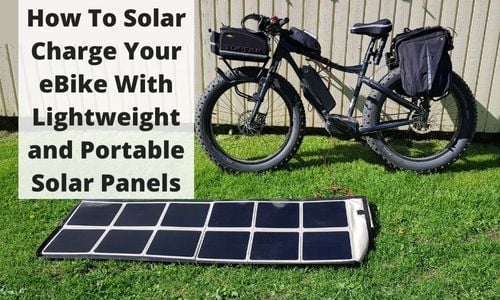
Originally published 4-28-2022.
Fuel costs have been climbing the past several years, with peaks reaching $7 per gallon in some areas of the US.
For many commuters, this added fuel expense is economically unsustainable. Many are turning to more cost-effective eBike transportation for their daily commute.
But how do you efficiently charge the battery when you are in a remote area or simply want to charge in a renewable way?
Take this blog post with you!
Today’s post will cover eBike components and features, specific use cases where an eBike makes sense instead of a traditional bicycle, and how beneficial solar panels can be for charging your eBike wherever you like to ride. Additionally, I’ll walk through how to wire up a solar charge controller that I use to charge my eBike.
In the image below is my electric fat bike. It's similar to a mountain bike but has larger, wider wheels and a more robust frame. It also has an electric mid-drive motor and a feature called pedal-assist.
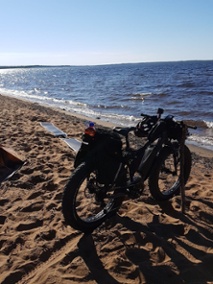
Pedal-assist augments the rider's peddling by taking up the slack using the bike's electric motor and battery to move you along.
Using a pedal-assist electric bike for commuting means not expending your energy solely to move the bike forward and helps you get to work without looking (or smelling) like you just rode the Tour de France mountain stage.
Commuting isn't the only activity an electric bike can help with.
My dog Snapper and I often head off on multi-day adventures using my eFat bike. I bring food, water, sleeping gear, shelter, and my ham radio gear if we get into trouble.
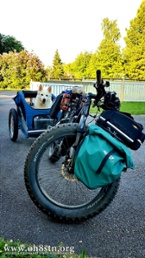

The load can become substantial when carrying food and equipment for myself and Snapper. Usually, that load would be pushed along 100% using my leg muscles and caloric expenditure.
This is okay until it's not.
Hitting the performance "brick wall" is when the electric mid-drive eBike motor can help.
While commuting or on one of our adventures when the hills are too steep or the road is too long, I can turn on the electric bicycle motor, making it easier to reach my destination, or keep it off and use it as a traditional bike.
With pedal-assist enabled, my own 100% effort becomes 90%, 80% or even a 50% reduction of my effort.
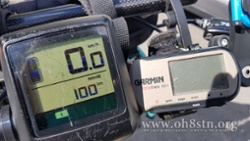
At roughly 100 kilometers or 62 miles range in pedal assist mode 1, my eBike can span most distances to my destinations and then back home, all without a recharge. Pedal-assist mode 1 is the lowest out of 5 assist settings. It provides a leisurely pace while the rider does much of the work and is also an excellent way to combine a daily workout without a morning or evening commute.
Some eBikes even have a throttle mode, allowing the motor to provide 100% of your forward motion, making carrying a heavier load more realistic on the path less traveled.
It also makes it possible to extend the range if, for some reason, you need to race against an incoming storm or unexpectedly need to find a better-protected shelter.
Unfortunately, without access to grid-tied electric outlets during a camping bicycle trip, the assistance only lasts until the battery dies!
As a content creator, my Subaru Outback provides the mobility needed for my adventure photo and video shoots. Along the way, I decided an electric fat bike could take me further (albeit not quite as fast) if I could figure out how to charge and recharge the battery at home and in the field.
Fortunately, I can use solar power to recharge the eBike battery off-grid with lightweight, portable solar panels.
In the following image, you can see my Subaru Outback and my electric fat bike side by side. While fuel prices were still reasonable, the Subaru was my daily driver. Naturally, I still use it for longer trips, heavier loads or when the weather is poor.
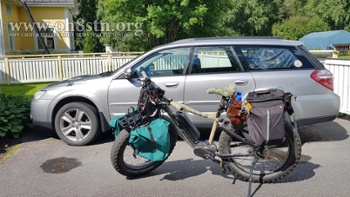
More and more, instead of jumping in the Subaru for a short trip, I use my eBike without any impact on my wallet or the environment because I charge it with solar power. In fact, my eBike has not charged via the grid since early 2022.
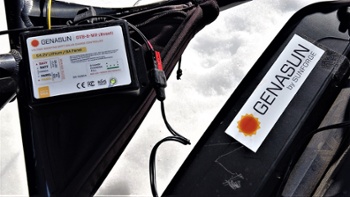
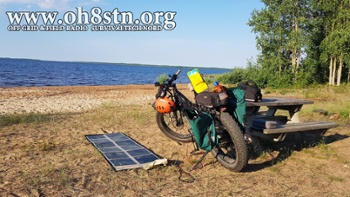
Today I use my eBike as transportation to and from my off-grid adventures and for getting around town for shopping, errands, and visiting friends. I even take my dog along for eBike camping trips.
My eBike Solar Charging Setup
My portable off-grid eBike battery charger combines a charge controller from Genasun and solar panels from PowerFilm Solar.
I have two different solar options that I use with my eBike. The first is two 60W Foldable Solar Panels (F16-3600) made with amorphous silicon solar material making them lightweight and flexible.
The second option is PowerFilm’s first-ever foldable crystalline panel. The 160W Crystalline Foldable Solar Panel (F3-48F28.3VKHAS) packs small and outputs a higher voltage than PowerFilm’s amorphous panels (this helps to reduce losses for higher voltage applications where a boost controller is necessary).
Here in Scandinavia, it can take 6-7 hours to fully charge the 14Ah eBike battery from flat to full, using the 160W Crystalline Foldable Solar Panel. Using a single 60W amorphous silicon panel could take up to 16 hours. Using dual 60W amorphous silicon panels take 10 to 12 hours for a full charge. Naturally, charging time can vary depending on the time of year.
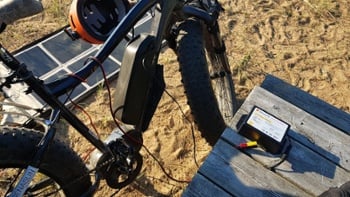
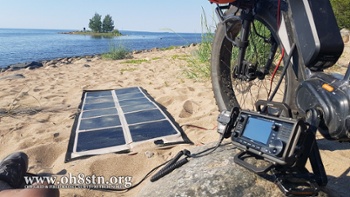
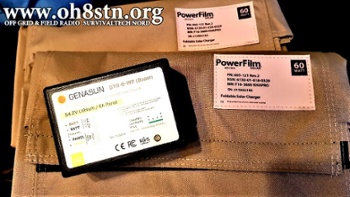
When arriving home, I connect the eBike to the solar panels and solar charge controller so it can charge while it sits outside. The eBike can also be stored away with the battery removed so that you can charge the battery independent of the bike.
As I find more ways to utilize my eBike in everyday life, I am now considering a second battery. This way, one depleted battery can be on the solar charger at home while a second fully charged battery powers the eBike. This will help in the winter months when there are fewer daylight hours.
The Solar Charge Controller I Use
The solar charge controller for my eBike battery (48V Lithium-Ion 13S Hailong battery) is the Genasun Boost charge controller (GVB-8-WP-Boost) for the 54.2V (48v Lithium-Ion) battery pack.
The controller takes voltage from the solar panels, converting it to a voltage the eBike can use for charging.
It also protects the battery from overcharging and finds the maximum power point (MPPT), making the best use of your panels.
How To Wire The Solar Charge Controller
The Genasun GVB-8 has four wires coming out of it.
Two are for connecting the solar panel, while others link to the eBike battery.
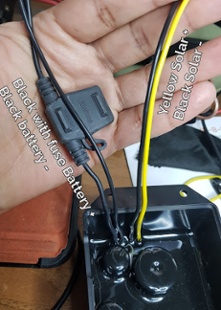
The wires are confusing, so please pay attention (see image above).
From right to left:
- Yellow wire: Solar input + (Positive)
- Black wire next to yellow: Solar - (Negative)
- Next black to left of solar - Battery Negative
- Next black wire on left: Battery Positive
Anderson Powerpole connectors are perfect for connecting the charge controller and eBike battery.
My eBike is a GZR Raw and uses a 48V Hailong battery to power a 250W Bafang M-Series (integrated Mid-drive) motor.
Wiring the Genasun charge controller for the Hailong 13S4P battery was straightforward.
I used the same charging port for off-grid charging as the stock AC charger when charging from home.
I added modular Anderson power pole connectors to the charge controller and the eBike’s battery charging cable.
This makes plugging in and swapping out simple, whether from home or during an off-grid adventure.
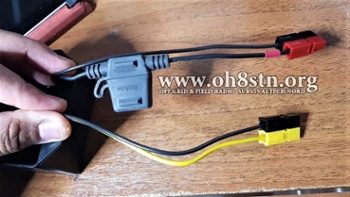
Whatever connectors you choose, be sure the individual wires don’t touch each other during connector installation.
Also, remove the battery and charge controller from any power source while connecting.
Solar Charging Your eBike
You will need a similar but unterminated version of your AC charging cable to charge the battery. We will add the Anderson Powerpole cables to the unterminated DC charging cable on the unterminated end.
The DC charging cable for the Hailong 13S4P Lithium-Ion pack looks like this.
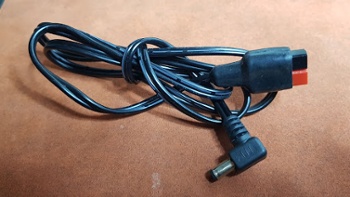
To charge the battery, I recommend removing it from the eBike.
Place the battery on a dry surface away from sources of moisture and remove any other connections from the battery.
Assuming you have already sourced an unterminated cable for your DC charging, plug your charging cable into the battery port of the charge controller.
Do not plug the solar panel in just yet. First, connect the male end of your charging cable to the charging port of your eBike battery.
You should see a green light illuminate the charge controller when connected, then blink green every second while the battery remains connected to the charge controller. It is now safe to plug in the solar panel.
If you get a red light illumination on the charge controller, the battery or charge controller is plugged into the incorrect port, or the polarity of the connection is backward.
If you don’t see a green or red light illumination on the charge controller, the fuse is probably blown.
Remove the fuse cover on the battery lead of the charge controller, then inspect the fuse with a multimeter.
If the fuse was blown, replace it with an identical fuse. Recheck your charge controller, battery connections, and polarity before plugging anything into the charge controller or battery again.
Remember to always connect your solar panel to the charge controller as the last step in charging. Remove the solar panel before the battery is disconnected from the charge controller when charging is complete.
Solar Charging Other Types of Batteries
If your battery is not configured the same way as the Hailong battery (for example, the 3-pin Bosch eBike battery), you can still charge your eBike battery off-grid with solar panels.
This video describes the connections required for charging Bosch eBike batteries.
Fuel costs have been climbing for the past several years, and for many commuters, this added fuel expense isn’t sustainable.
eBikes are a great way to get around, get quality exercise, and go further than you could with a conventional bicycle. This, combined with a lightweight, portable solar charging solution, makes this mode of transportation sustainable and efficient!
If you want to learn more about my particular setup or how to create yours, please don’t hesitate to reach out.
About Julian White
Julian White, aka OH8STN, is a YouTuber, blogger and retired broadcast engineer.
His blog and popular YouTube videos share education and adventures with the off-grid ham radio and emergency communications communities.
Take this blog post with you!